Ann Arbor’s Climate Strategy
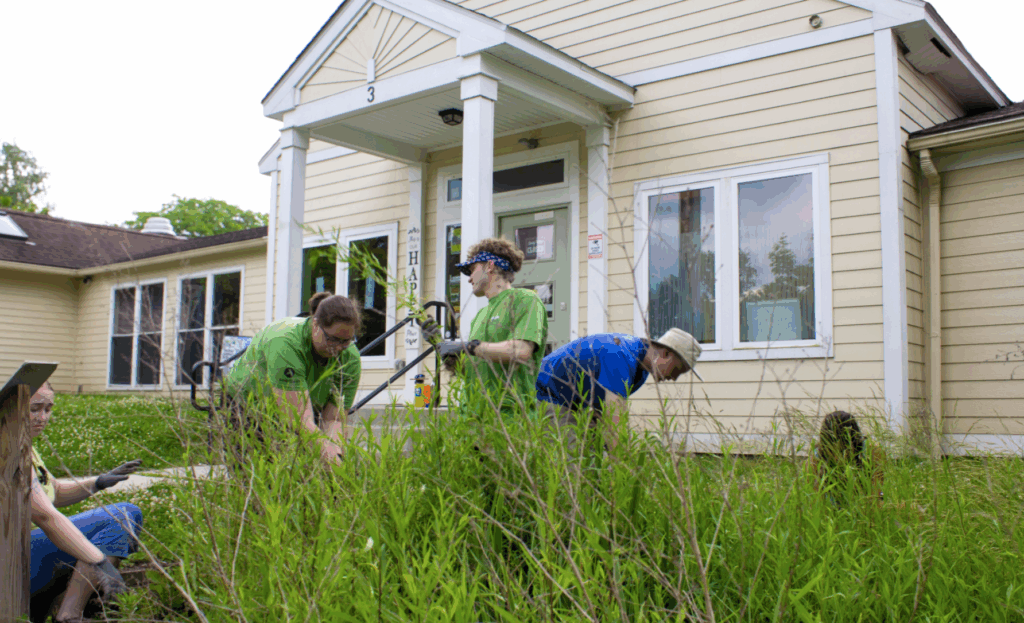
In 2020, the City of Ann Arbor adopted A²ZERO, a climate action strategy designed to achieve community-wide carbon neutrality by 2030. The plan outlines a framework for embedding sustainability into city operations, economic growth, and everyday decision-making, while also emphasizing equity and long-term resilience. One of the most visible efforts under A²ZERO is the Bryant project, a first-of-its-kind initiative to transition an entire neighborhood—home to more than 250 households—toward carbon neutrality. The project combines energy efficiency upgrades, renewable energy, and community-centered planning to create a scalable model for neighborhood-scale decarbonization. Leading the A2ZERO program is Missy Stults, Ann Arbor’s sustainability and innovations director, who helped steer the A²ZERO plan’s rapid development and continues to guide its evolution. SBN Detroit interviewed Stults about how the plan is shaping the local economy, what other cities can learn from Ann Arbor’s approach, and the challenges and opportunities that lie ahead. Q: How is sustainability fueling the local economy in Ann Arbor, and what benefits are you seeing from the A20 plan? A: We’re working to institutionalize sustainability as part of the culture, and we are seeing it manifest in multiple ways. Tech entrepreneurs are innovating around clean energy and mobility. In the circular economy, businesses are repurposing materials or finding second lives for decommissioned electronics—like harvesting valuable parts from old phones. I see this as a movement by which people make choices not just because they’re profitable, but because they’re right, and we’re making them more convenient. Over time, that mindset fuels business innovation and economic resilience. Q: What differentiates A²ZERO from other cities? A: First, the speed. We built this plan in 82 days. Second, we never pretended it would be perfect – we focused on what was possible and necessary. We talk about the planning being a living framework for our work, something that is directional but not the directions for where we need to go. Third, we anchored it in three pillars: equity, sustainability, and transformation. Equity is the center of the work (not just a lens we look through). Sustainability means it must last well beyond any of us. Transformation acknowledges that the systems that created this crisis cannot be the systems that solve it. Lastly, we also didn’t shy away from costs. It would have been easier to gloss over the investments needed, but we were transparent. That honesty has required us to be bold and very vulnerable, and I think that differentiates the Ann Arbor process. Q: How has the strategy evolved since its 2020 adoption? A: Constantly. Telework is a good example. The original plan was written in 2019, just before the pandemic. Telework wasn’t part of it – then suddenly it became central. The plan is directional, and we adapt to cultural, political, and financial moments as they come. Another example is tree planting. Our goal was to plant 10,000 trees later in the plan, but in 2020, we pulled that forward because it was work we could do during the pandemic. We’ve now planted 11,000 trees. That’s the beauty of a living document – It allows us to be nimble while staying aligned to the overall direction. Q: If you could think freely – blue-sky style – what environmental innovation or policy would you love to see Ann Arbor implement next? A: If a flood is happening, the first thing you do is turn off the faucet before you clean up. We need that mindset here. We need building codes and regulations that stop allowing new buildings that pollute. We need aggressive codes that require polluters, such as manufacturers and industrial operators- not individuals – to take responsibility for the pollution they are creating. That kind of systemic shift is essential. Q: What key lessons can other cities learn from the Bryant project? A: The importance of trust. It’s something you can’t underestimate. The community has to determine the end goals. And you have to show up consistently, even when the answers aren’t easy. Early on, people asked, “What if Bryant gentrifies?” We didn’t have an answer – but we said that out loud and committed to figuring it out together. Persistence and vision matter. People need hope, but hope without action is empty. In Bryant, we’ve paired hope with concrete steps – like stabilizing utility bills through energy efficiency improvements- and that sequencing is critical. Now the project has momentum, and we are looking at things like installing networked geothermal. Q: Given recent setbacks—like reduced federal funding and legal barriers—what’s your strategy for sustaining progress? A: Force and persistence. There’s no option but to keep doing this work. Well, the only option is complacency, and that won’t happen. Success begets success. Our goal is to institutionalize sustainability so deeply that it doesn’t matter who is in my role – this will be part of Ann Arbor’s DNA. It’s important to note that local governments have historically had do this without much federal support. The Biden administration was an outlier. We are used to working under challenging conditions, and we will continue regardless. Q: What are some recent wins or innovations? A: In November 2024, voters approved creating the nation’s first sustainable energy utility—an opt-in utility that is supplemental to the existing investor-owned utility, and a utility that only offers energy from renewable energy sources. That’s transformative. In Bryant, we’ve secured $18 million, including a $10 million federal geothermal grant we hope is finalized soon. That would be one of the first large-scale demonstrations of an alternative heating and cooling model in the country. We’re also piloting a circularity initiative with returnable containers, which could scale into broader partnerships. I’ll stop there. There’s much more being done, but these are some good examples of the transformation that’s happening. Q: How are you tracking outcomes? A: We use a mix of metrics. Some update automatically every day into a reporting dashboard we have; others are annual. We’re close to releasing the 2024 annual report. But we also recognize that not everything that matters can
Restoring Detroit’s Tree Canopy
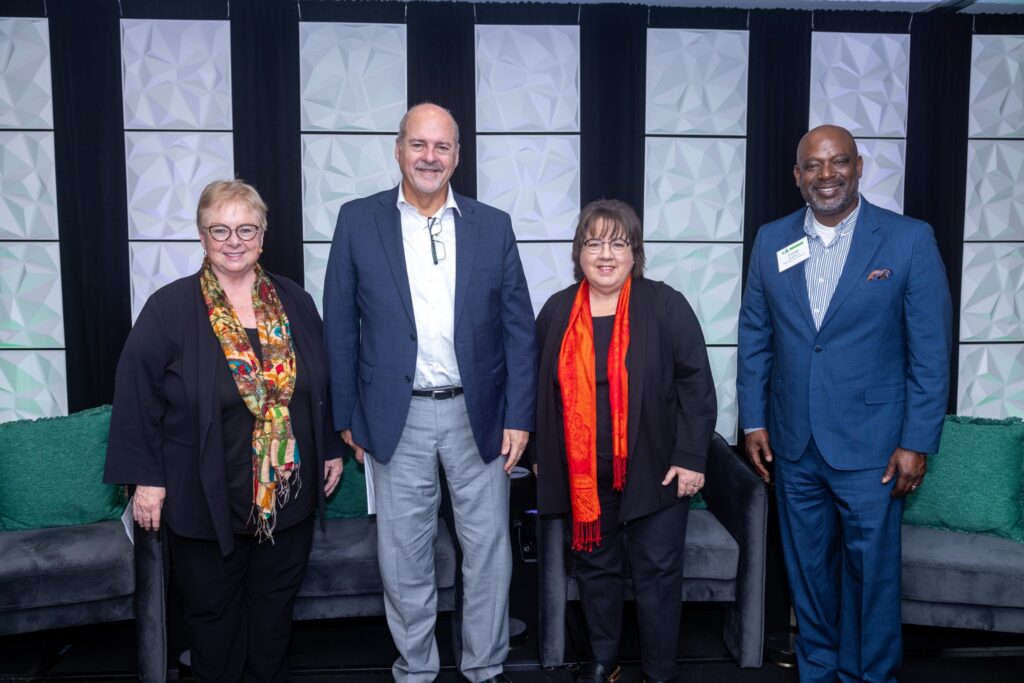
Detroit was once known as the “city of trees,” but disease, invasive insects, and budget cuts over time have decimated our area’s distinctive tree canopy. But efforts are underway to replenish trees while also providing job training, green spaces, education, and community engagement. On Oct. 31, 2024, Sustainable Business Network Detroit hosted an informative discussion sponsored by the Fred and Barbara Erb Family Foundation regarding these efforts and how restoring tree canopy benefits individuals, neighborhoods, businesses, and the economy. The panelists were: Lionel Bradford, president and executive director, Greening of Detroit, a nonprofit focused on enhancing the quality of life for Detroiters by planting trees, providing job training, and involving youth in the education of the natural environment. It involves Detroiters in the process through community engagement, green spaces, education, and jobs. Maureen Donohue Krauss, president and CEO, Detroit Regional Partnership. DRP works to serve as a single point of contact for information, connection to services, incentives, and data for businesses who want to locate or expand in the 11-county Southeast Michigan Region. Robert Riney, president and CEO, Henry Ford Health, and leader of HFH’s $4 billion Destination: Grand initiative. The project includes a $2.2 billion expansion of HFH’s Detroit campus anchored by a new state-of-the-art hospital facility that will span 1.2 million square feet. It includes a 20-story patient tower, with three floors dedicated to providing intensive inpatient physical medicine and rehabilitation in partnership with the Shirley Ryan AbilityLab and its own Central Energy Hub, making it one of the largest fully electric-capable hospitals in the country. The event was moderated by Terry Barclay, president and CEO of Inforum, and chair of SBN Detroit. Some of the takeaways: The case for tree canopy Lionel: Growing up in Southeast Louisiana – which is very hot – you quickly learn the value of a tree. It’s also a sportsman’s paradise – We did a lot of hunting, fishing, and camping, and I developed a great appreciation for the environment and its value. I also love people. The work that we do is about people at the end of the day, so when we do this work it’s to build community and neighborhoods. We try our very best – changing landscapes and lives is our motto. When someone has been incarcerated for 20 years and needs a second chance, they can come through your program – the Detroit Conservation Corps – and they can be trained and support their families. You can train people to put trees in the ground and maintain them. Maureen: Part of my role is to inform people that economic development is more than just a new factory in your town, more than just a tax abatement. It’s creating an environment that both people and companies want to be in. Sixty percent of our projects are from international companies – when people come here for the first time, they have expectations of what a first-class city looks like… Think about Paris and its phenomenal tree canopies. People want that here. I did a little research before this event: Homes with trees sell two days faster and for 15% more than homes without. Tree value increases with age – the cost of trees has 100% payback. Three properly placed trees can reduce air conditioning by 56% and reduce home heating bills by 10% by serving as a windbreak. Bob: You may think what does a healthcare system have to do with tree canopies? HFH is absolutely committed to increasing the health of communities – the role that hospitals and doctors play is about 20%. We don’t underestimate the power of that 20%, but true health – meaning how long people will live and have a high-value life – is a partnership of healthcare, policy, and environmental factors – which are huge. You may have seen that the biggest determinant of your health is the ZIP Code that you live in. You need to have fabulous healthcare, access to it, economic security, environmental security, and food and nutrition security. At HFH we need to be a population health company – we pick and choose how we should make our mark and one of the things we believe in is the power of the tree. We have to walk the talk. The economic benefits of tree canopy Maureen: Our organization has three pillars: market, grow, and support. It’s so much better now. People are curious to hear about Detroit and see what’s happening. Talent is No. 1 – we have the second-highest amount of engineers in the country and have experienced manufacturing talent. As one of my teammates says, it’s workforce, weather, and water. When you talk about climate change, Michigan will be in the top five least affected. The right amount of tree canopy and how trees are sourced Lionel: American Forests did a study and determined that a city the size of Detroit should be at 40%. Right now we’re at 26%. We lose about 2,000 trees a year, so those have to be taken into account. We get most of our trees from New York and Indiana and, more recently, Wholesale Tree Inc. in Northern Michigan. More importantly, we’re growing our own trees now – running the Walter Meyers Nursery in Rouge Park, which is owned by the city. We’re very intentional about turning into a full-fledged operational business. Last year, we harvested our first set of trees. We have lost a lot of trees over time, and the reason we have lost a lot of those is because the city lacked the resources, and dead trees were not removed and were taken down by storms. This administration has done a great job by taking trees down when dead and dying. Working with DTE has been quite thrilling – they have given financial support to planting trees but also to making sure that the next generation of environmental stewards are trained by supporting our Green Corps summer programs and also the tree
New Leadership to Focus on Sustainability, Connectivity, Infrastructure

Meagan Elliott began her tenure as president and CEO of the Belle Isle Conservancy on July 1, following a decade with the city of Detroit, culminating in serving as chief parks planner and deputy CFO overseeing development and grants. Elliott spearheaded the Joe Louis Greenway Framework Plan and played a pivotal role as the city lead in a $350 million campaign for a unified greenway encompassing the Joe Louis Greenway and the Detroit Riverfront. The Belle Isle Conservancy is dedicated to safeguarding the natural environment, preserving historic structures, and enhancing Belle Isle as a public park for the enjoyment of all, now and in the future. According to the Michigan Department of Natural Resources, 5.6 million people visited the park last year. SBN Detroit interviewed Elliott about the conservancy’s approach to sustainability and what impacts her work will have on Southeast Michigan businesses and residents. Q: What part will sustainability play in your new role? A: Sustainability is fundamental to everything we do, and I want to lift and advance it in new ways. The Belle Isle Conservancy has done and continues to do a lot of work toward this. One example is the Keep Belle Isle Beautiful campaign focused on reducing plastic waste on the island and in waterways. That initiative has taken off and now goes far beyond the cleanups themselves, focusing on environmental stewardship and informing educational programming that helps to drive our future leaders. Caring for our planet forms the foundation of all our endeavors and is a filter for how we approach all our work, whether it be in support of habitat restoration, capital projects on the island, or new types of programming moving forward. I’m eager to collaborate with the Michigan Department of Natural Resources in this effort. Q: How does your background position you for this role? A: It’s in a couple of important ways. My tenure as chief parks planner was particularly formative, involving comprehensive work across all city green spaces, from neighborhood parks to a 30-mile greenway. When we consider Detroit’s park infrastructure, connectivity emerges as a fundamental concept. Historically, Belle Isle has been perceived as a separate entity and not easily accessible. Moreover, with one in four people in Detroit lacking access to a vehicle, they face challenges moving around the city, being able to access our amazing metro parks system, or getting Up North. Belle Isle is a treasure that rivals all of these spaces, and here it is right in our front yard. Connecting to a system of green space via the riverfront and the Joe Louis Greenway is essential. Connectedness extends beyond physical spaces to encompass the desires of residents and businesses surrounding Belle Isle as well. The Belle Isle Conservancy plays a crucial role as a steward and advocate, driving initiatives that reflect community wants and needs. Also, my background in sociology has prepared me to spend time listening to residents and how they want to utilize their island and to make sense of the patterns that emerge in engagement with a diversity of constituents. Finally, I’ve spent the last three years as deputy CFO brokering partnerships between private funders, philanthropic entities, and public partners and making initiatives happen by creating coalitions of folks. I want to put that same energy and investment behind Belle Isle. Q: You led the Joe Louis Greenway Framework Plan, and were the city lead in the $350 million campaign for a unified greenway for the Joe Louis Greenway and the Detroit Riverfront Conservancy. How will this impact your work going forward? A: I have an example. On my first day as president and CEO of the Belle Isle Conservancy, I was speaking at a press conference during which $20.7 million was received from the federal government for the continuing construction of the Joe Louis Greenway. This was a grant that the team worked on while I was still working for the City of Detroit. But I was there as the co-chair of the Joe Louis Greenway Partnership and was able to highlight the connection from the Joe Louis Greenway to the Iron Belle Trail, which ultimately will connect Belle Isle to Ironwood at the tip of the Upper Peninsula through a network of greenways. Many individuals have dedicated themselves to this work for a long time, and I’m committed to utilizing my platform and voice to continue to advance this work. Belle Isle is the epicenter of both this amazing network of green spaces and the Great Lakes. I can’t imagine a better geography for foregrounding environmental stewardship than on this island. Q: What impact do you think the Belle Isle Conservancy has on businesses in Southeast Michigan? A: I see the economic impact of public space as vast. It directly relates to employee decisions on where they choose to live and work. Belle Isle ranks as the second most visited park in the country after Niagara Falls. I believe our efforts here are directly linked to attracting new talent to businesses in Southeast Michigan and bolstering our economy. Q: In what way will you work with area businesses? A: The conservancy already does a lot of work with businesses on many fronts. One of the most immediately valuable impacts businesses have on Belle Isle is our corporate stewardship days. Businesses bring their teams to help clean up the park and connect with each other. We also have a significant number of partners in the corporate community who see the value of Belle Isle for the community and invest in projects to help support the park. We also have the opportunity to look at the vendors utilized on the island and how to create more inroads for Detroit-based businesses to play a role in the construction, management, concessionaire, and other vendor partnerships. There are endless opportunities to work together. Q: What challenges do you expect to encounter from a sustainability aspect? A: The challenge is always prioritization and how to choose projects and
The Cleanup Club: Working to Mitigate Plastic Pollution in the Great Lakes
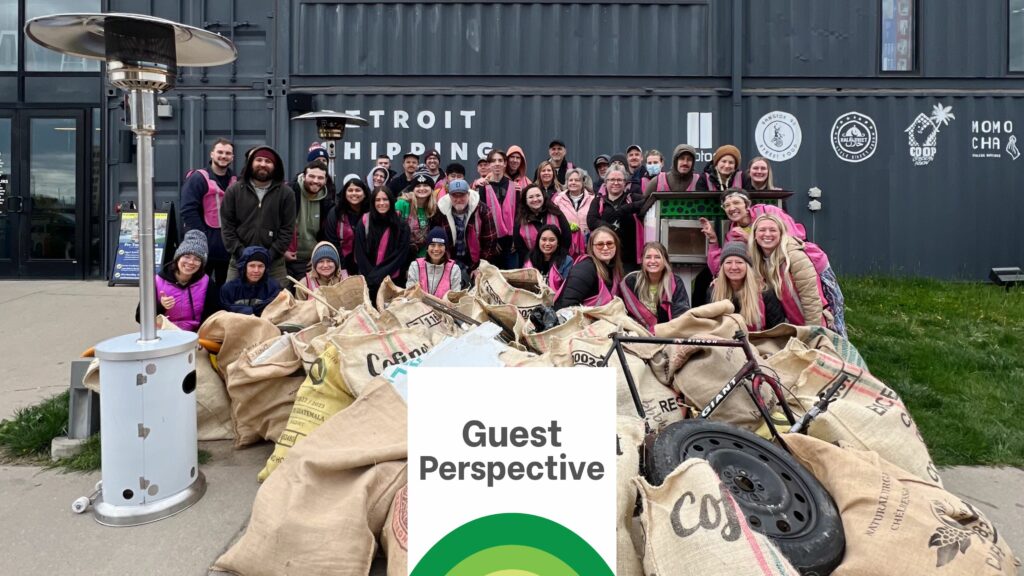
HANNAH TIZEDES IS THE FOUNDER AND EXECUTIVE DIRECTOR OF THE CLEANUP CLUB Before founding The Cleanup Club, a nonprofit dedicated to protecting our communities and Great Lakes from plastic pollution through cleanups and creativity, I amassed a collection of over 100,000 pieces of plastic debris from the Great Lakes shorelines during solo cleanups. I used the colorful found objects to create thought-provoking art pieces and installations to inspire conversations about how we can all play a role in protecting the places we love. Creativity has continued to play a key role in The Cleanup Club’s mission to protect our communities and Great Lakes from plastic pollution while having fun. We aim to serve as an approachable source to help educate and spark dialogue with people online and in person about the urgent need for action to protect our freshwater resources. In 2016, a study from the Rochester Institute of Technology revealed that nearly 22 million pounds of plastic pollution enter our Great Lakes every year, with major cities such as Detroit, Chicago, and Toronto being primary sources. By 2024, plastic production has continued to increase globally, and so has the urgent need to protect our waterways from harmful impacts. This is particularly crucial as these bodies of water provide drinking water to over 40 million people across the US and Canada. Recent studies have shown that topics such as climate change and plastic pollution often leave people feeling frightened and negative. With the rise of terms like “eco-anxiety” and studies emphasizing the growing harms of plastic pollution, The Cleanup Club aims to push forward crucial work for a more sustainable future and cleaner waters. At the same time, we strive to create an uplifting community that empowers individuals, communities, and businesses to take action together through joyful and collaborative experiences. We understand that working together is essential when it comes to finding upstream solutions and mitigating plastic pollution in our region. This is why The Cleanup Club values collaborating with aligned local businesses and global brands. We aim to educate and expand the conversation about Great Lakes plastic pollution through community cleanups, educational programming, and interactive creative projects around Michigan, focusing on Southeast Michigan. When partnering with The Cleanup Club, local businesses enjoy the benefit of a passionate group of volunteers cleaning up their neighborhoods while driving awareness and business to their unique offerings. Past partners, contributors, and sponsors include Walking Lightly and 86 Plastic (local zero waste stores in Metro Detroit), Dessert Oasis Coffee Roasters, HiBAR, Detroit Shipping Co, Belle Isle Conservancy, Royal Oak Sustainability, and more. Community events are not only fun ways to get outside and take part in collective action but also serve as a way to collect data on top-polluting items and top-polluted areas for advocacy and research efforts that further promote upstream solutions. While we acknowledge that cleanups are not the ultimate solution, we strongly believe they play an accessible and active role in education and advancing our collaborative efforts for a brighter, more sustainable future for people and the planet. Learn more at www.thecleanupclub.org and follow on Instagram at @the.cleanup.club. Be sure to subscribe to our newsletter for regular updates on sustainable business practices in and around Detroit.
Perspective on Eliminating Food Waste
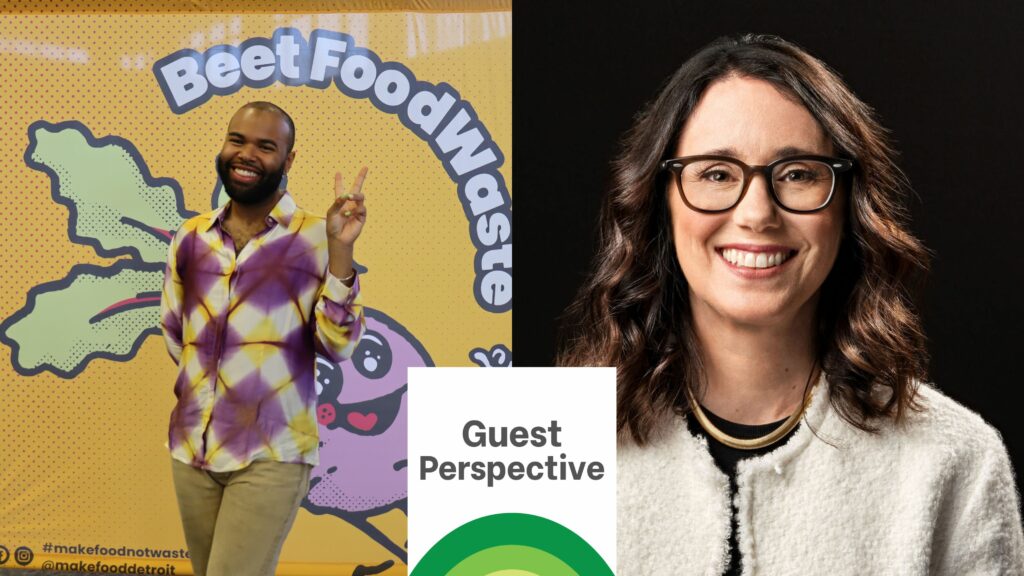
DANIELLE TODD, IS THE EXECUTIVE DIRECTOR OF MAKE FOOD NOT WASTE Landfilled food is one of the primary sources of climate change due to two main reasons. First, food decomposing in landfills emits methane, a greenhouse gas 25 times more potent than carbon dioxide. Second, landfilled food represents a waste of land, water, and transportation resources that cannot be reclaimed. Given the substantial volume of food we send to landfills, methane emissions are skyrocketing and our resources are depleting at an alarming rate. Annually, Michiganders discard more than 2 billion pounds of food, resulting in approximately one-third of our landfills being composed of food waste. This excessive waste leads to the negative impacts of extreme weather such as flooding and power outages. It deteriorates air quality, threatens our food supply, and endangers vital plants and animals. Consequently, the State of Michigan, along with the U.S. government and the United Nations, has set a target to halve food waste by 2030. However, with 2 billion pounds of food still being landfilled annually, achieving this goal within six years presents a major challenge. Despite the fact that the problem is so great, eliminating food waste from our landfills is not all that difficult compared to other climate-related changes we need to make. Yes, it’s something we all must do, but it’s also something we all can do. According to the United Nations, more than half of the food waste comes from our homes. That means all of us can make a huge difference in this issue by changing how we handle food in our kitchens. For a fun way to get started, join our 7 Day Food Waste Challenge. You’ll learn the basics and begin to set up some habits that will drive down the amount of food you throw away. Of course, food waste happens outside of homes too. And if we’re going to reach the State’s goal in less than six years, we need a concerted plan. That’s why Make Food Not Waste has launched The 2030 Project, focusing on Southeast Michigan, the region with the highest population density. Concentrating efforts in this area is strategic, given that a larger population corresponds to greater amounts of waste. The project’s objective is to divert all food waste from landfills in the top 15 cities in the region. By collaborating with 17 local and national partners, Make Food Not Waste is crafting a detailed plan incorporating best practices in food waste reduction from across the country. The project’s approach underscores two critical principles: first, there is no singular solution to food waste. Second, we can only stop food waste by working together. While skeptics may argue that completely eliminating food waste from landfills is unattainable, we feel otherwise. It does not require the invention of groundbreaking technology or a defiance of natural laws. Rather, we simply need to stop throwing our food in the garbage. While establishing infrastructure, logistical frameworks, and educational programs pose challenges, they are not insurmountable. The alternative—continuing to waste our resources and make our planet hotter – is not something we can live with. Learn more at www.makefoodnotwaste.org. Be sure to subscribe to our newsletter for regular updates on sustainable business practices in and around Detroit.
The Economics Behind Sustainability for Commercial Real Estate
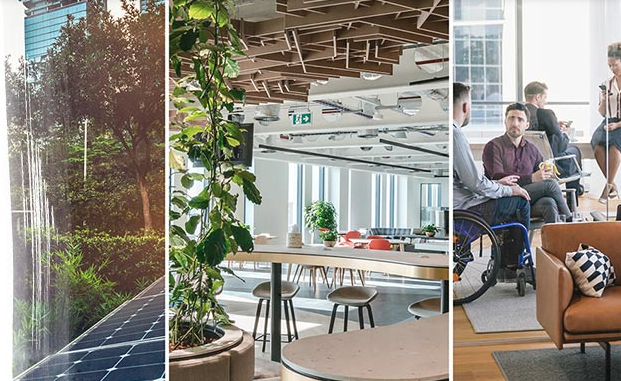
JLL, incorporated as Jones Lang LaSalle, is a global real estate services company with over 100,000 employees and offices in 80 countries. The company launched its sustainability services business in 2021 and it now has over 1,000 sustainability professionals working in this capacity globally. Greg Bolino, JLL’s head of global sustainability strategy & assets, explained the company’s approach to SBN Detroit. Q: What can you tell us about JLL’s sustainability services? A: Our mission is to help clients achieve their sustainability goals, and we know this will help us achieve our goals and result in JLL being more sustainable as a business. Our sustainability services are built on three pillars: Consulting, which involves advising clients on investment strategies and asset planning; Clean Energy – assisting those who invest in infrastructure to ensure their initiatives involve clean energy; and Sustainable Operations, which focuses on helping clients achieve their sustainability goals within their facilities. Q: When was this established and what is the impetus behind it? A: The company has been doing things related to sustainability for years. In 2021, I was brought in to transform the practice to formalize and scale these services. Q: JLL has 30,000 people trained in sustainable real estate – how do you define sustainable real estate? A: We focus on four things when it comes to sustainable real estate: carbon lifecycle; resource decisions such as waste and water consumption; social value; and risk, which includes physical climate impact, business risks, and economic risks. We trained 30,000 employees to have a working knowledge within these areas, 2,500 of our employees are network champions and advocates, and 1,000 practitioners work in the Sustainability Services group full-time. Q: How do you approach increasing the value of a client’s portfolio with sustainability at the forefront? A: We work with real estate investors and corporations. When it comes to investors, if we look at office leases in the U.S., 34% of leases will renew in the next two years. More and more companies are looking for space to help them reach their decarbonization goals. This puts pressure on owners of facilities to invest in decarbonization. So, we are helping investors think through the rationale for making these investments. Many big corporations such as banks and tech companies that lease space are just starting to work out their carbon pathway. We help them bridge that chasm by rethinking their locations, relationships with landlords, and capital investment plans. So, both investors and corporations have consequential decisions at hand when it comes to decarbonization and sustainability, and we help them work through these issues. Q: The JLL website states that 40% of carbon emissions globally come from buildings, so decarbonizing real estate is fundamental to securing a more sustainable future. What can you tell us about this? A: The 40% number is the most quoted figure in real estate. I think that understates the size of the challenge. Transportation and buildings combine to make up the majority of a large city’s carbon footprint. This is why so many cities are setting standards to compel buildings to do more. Even companies whose real estate is a small part of their carbon footprint want to decarbonize their buildings now because it’s the first thing people see, and they want to be clear about their commitment. The greatest pressure is coming from employees on this front. Q: What are some examples of work you do in Southeast Michigan? A: JLL has offices all over Michigan including in Ann Arbor, Royal Oak, and Detroit, and we have our hands in so many things. I’ve advised Michigan utilities, the city of Ann Arbor, and local developments working on sustainable communities. I’m a founding board member of the Equitable Ann Arbor Real Estate Trust focused on more development of affordable housing. We work locally and globally. Q: JLL has a net-zero target validated by the Science Based Target Initiatives collaboration between the CDP (Carbon Disclosure Project), the United Nations Global Compact, World Resources Institute, and the World Wide Fund for Nature. What does this mean? What actions are you taking internally to address sustainability? A: JLL was among the first in our industry to commit to emissions-reduction targets based on criteria set by the Science Based Targets Initiative (SBTi). Our goal is to reach net-zero greenhouse gas (GHG) emissions across scopes 1, 2, and 3 by 2040. We have a near-term target to reduce emissions by 51% by 2030. This is a massive goal. 96% of our carbon footprint consists of our client’s facilities. So, our internal commitments and goals flow through to our clients. Q: What are the market forces you are up against? A: The U.S. office sector is going through a difficult time. High-interest rates make improvements challenging. In the US, we are the slowest to return to work anywhere around the world. Weak occupancy in buildings has contributed to slowing retrofit investments. Buildings are the least digitized asset class, making analytics and modeling more challenging. Q: What is the end game? A: The end game is simple – sustainability must be baked into how Real Estate is bought, sold, and managed. We are moving to a place where we must do business more sustainably. The whole value chain has to change. It’s inescapable that the market and employees are watching these commitments. There is no way companies can ignore or withdraw from these goals. The economics behind moving to sustainability are getting stronger and stronger. Be sure to subscribe to our newsletter for regular updates on sustainable business practices in and around Detroit.
Moving Toward a More Just and Sustainable Future in Southeast Michigan
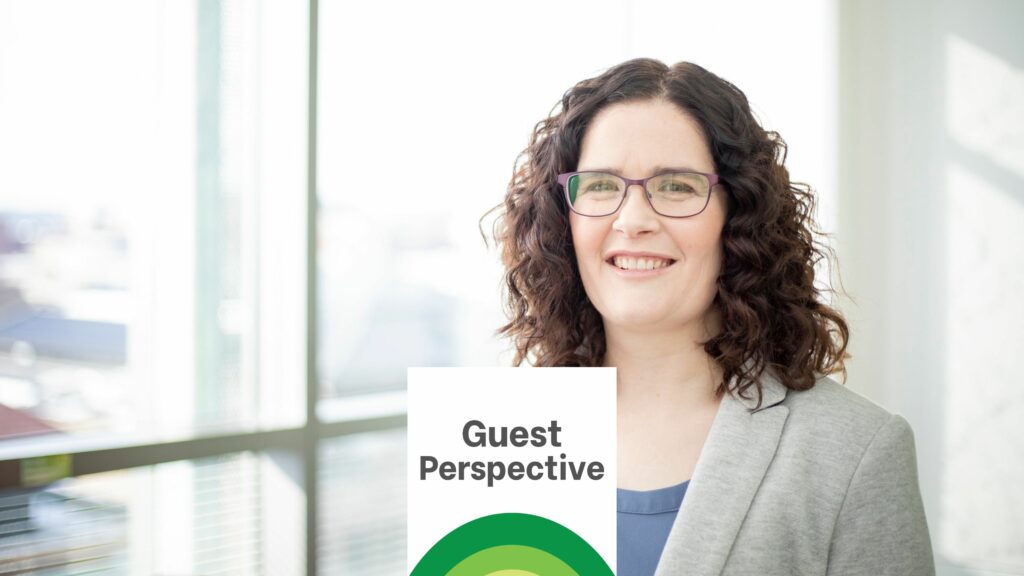
Sara Soderstrom is an associate professor in Organizational Studies and Program in the Environment and the Erb Undergraduate Fellows faculty director at the University of Michigan. Sustainability has evolved significantly over the years. At the University of Michigan’s Erb Institute for Sustainability in Business, this evolution includes working toward market transformation: business transforming the market to make it more sustainable. We can’t be thinking only: ‘How do we do less bad? How do we pollute less? How do we use fewer resources?’ We need to actually think about ‘How do we do more good?’ That fundamentally pivots the way that you think about business—it’s much more of a proactive than reactive conversation. It also centers justice in a way that early business sustainability didn’t. This shift changes the local vs. global dynamic to consider the local as part of the global system, and it sharpens the focus on small and midsize businesses. It also considers supply chains and key stakeholders more broadly. A study that I conducted with Kathryn Heinze, associate professor in the School of Kinesiology at the University of Michigan, shows some of the ways these shifts are happening. The study focused on the nonprofit FoodLab, which was operating in Detroit at the time. FoodLab aimed to promote healthy, environmentally sustainable, and accessible food systems and to grow a good food economy by working with its members: local food entrepreneurs. One thing that we realized as we were working with local entrepreneurs was a focus on being embedded in place—what is Detroit? What is the commitment to the city? What is the future for the city we envision? And how do we place ourselves in that future as entrepreneurs? With this network of businesses, there was a strong motivation not just for the financial viability of the business, but for doing good through business. But at the same time, these entrepreneurs have resource constraints, so there are tradeoffs. How do you balance things like a living wage with ensuring composting or locally sourced materials? FoodLab helped ease some of these constraints by serving as a connector that lowered the barriers to entry around sustainability. This way, each entrepreneur didn’t need to have all the answers or all the resources—they could get the information they needed about sourcing, financing, or best practices through the network. FoodLab functioned as part incubator, part social movement organization, connecting folks with these shared interests to collectively learn, but also as the space that could aggregate these resources and make them accessible to people, so that they could more effectively move forward towards sustainability and justice goals. FoodLab asserted that they couldn’t have a just and sustainable food economy if there wasn’t engagement, ownership, and voice from diverse entrepreneurs that reflect the City of Detroit. So they had a lot of intentionality around diversity and engagement, both in who was participating as entrepreneurs in the network, but also in what they were prioritizing as their goals as an organization. It was centering equity and justice in almost every conversation and decision they were having. The ways that FoodLab built its organizational practices and structured conversations made sure that everyone involved felt like they were heard, even in contentious conversations, which built trust and helped them move collectively towards this more just and sustainable imagined future. The Erb Institute – a partnership of the Ross School of Business and the School for Environment and Sustainability at the University of Michigan -. works to create a sustainable world through the power of business. Somewhat like FoodLab, we also serve as an enabling network. The students are the key actors, We are the convener, and then the network continues with alumni who are now 10 to 20 years out but still lean into us and each other for support as they work toward solutions to sustainability and justice challenges. Two of our key programs are: Impact Projects, through which students design projects, often working directly with businesses or partnering with businesses and community partners on organization-led projects. The projects give businesses access to students who have time, expertise, and passion around sustainability and justice efforts, who can help them focus on an issue—such as supply chain, procurement, or skills redevelopment. Erb on the Road, which brings both graduate and undergraduate students to businesses, nonprofits, and other organizations across Michigan. The program allows students to engage with a variety of different types of businesses and nonprofits that are focused on local sustainability challenges and figure out solutions for them. For undergrads specifically, what has been powerful is hearing them reflect on learning what is happening locally—which makes what we talked about in the textbook real—but their experiences are helping them recognize that business and sustainability is an available career path. People are committed to sustainability in myriad ways, and you don’t need to wait until you are chief sustainability officer to do sustainability. The Erb Institute is focused on preparing future leaders – and also service to the state of Michigan. We want students to recognize that being part of the University of Michigan isn’t just the Ann Arbor campus – it’s also the state and world. So we work to help focus that commitment to: What does it really mean to be the leaders and the best? Supporting and engaging locally in Detroit and across Michigan is part of that. Be sure to subscribe to our newsletter for regular updates on sustainable business practices in and around Detroit.
Detroiters Working for Environmental Justice’s Vision for Sustainability

LAPRISHA BERRY DANIELS IS EXECUTIVE DIRECTOR OF DETROITERS WORKING FOR ENVIRONMENTAL JUSTICE AND A LEADERSHIP COMMITTEE MEMBER FOR SUSTAINABLE BUSINESS NETWORK DETROIT DWEJ’s vision for sustainability is rooted in the three pillars of sustainability: health and happiness of community members, a healthy local environment free from hazards and harm, and economic vitality. As an organization that focuses on environmental justice and strives to have the voice of the community-centered as decisions are being made that impact their health (physical, mental, spiritual, and economic), we assert that community members can envision and create healthy communities that meet their immediate and distal needs. A healthy community is one in which all systems work together to support the health and well-being of all its members. Local businesses are part of the community’s ecosystem and thus play a unique role in supporting the health and well-being of the community. Ideally, the relationship between community members and local business is mutually beneficial as they prioritize health and co-create a healthy community. Local businesses and community members can work together to identify threats to community well-being and create strategies to address challenges. In Detroit, and beyond, climate change threatens our ability to achieve and maintain physical, mental, spiritual, and economic health. As we experience more extreme weather locally, such as extreme heat and annual “100-year floods”, we recognize that our built environment may not be able to weather the storm (pun intended). Unfortunately, our existing residential housing stock and current construction practices are too often ill-suited for current and future climate conditions. The mismatch between what is available and what is needed creates threats to the health of people and planet. DWEJ developed a contractor accelerator program that focuses on contractors increasing their awareness about ways to improve the built environment to mitigate risks related to climate change while centering sustainability. DWEJ’s contractor accelerator program, Building Health, serves as an incubator to support peer-to-peer learning among Detroit-based, Detroit-serving contractors of color. Building Health increases contractors’ awareness and implementation of “environmentally responsible and resource-efficient” practices that have: Bottom-line business benefits Individual and community health benefits Decrease environmental degradation. Building Health increases contractors’ understanding of the impact they can have on health. For example, participating contractors are presented with strategies for upgrading and greening residential housing in ways that include the use of various building methods and materials that can make homes more energy efficient. These improvements decrease greenhouse gas emissions, improve the health and comfort of the home, and improve the economic health of the occupants by reducing the cost of utility use. Participants receive financial and technical assistance to implement practices as part of the program as well. Additionally, contractors learn how to best communicate the benefits of sustainable repair and rehab practices to clients. The role of local contractors is just one example of the opportunity our community has to transform our ecosystem and economy for the better. There is a unique and distinct role that local business plays in supporting people and planet. Sustainability is an iterative process where we must work collectively toward the goal of having healthy and vibrant places in which to live, learn, work, play, and pray. — Check out Laprisha Berry Daniels’s recent #TEDTalks: Lessons from the Past on Adapting to Climate Change Be sure to subscribe to our newsletter for regular updates on sustainable business practices in and around Detroit.
University of Research Corridor Sustainability
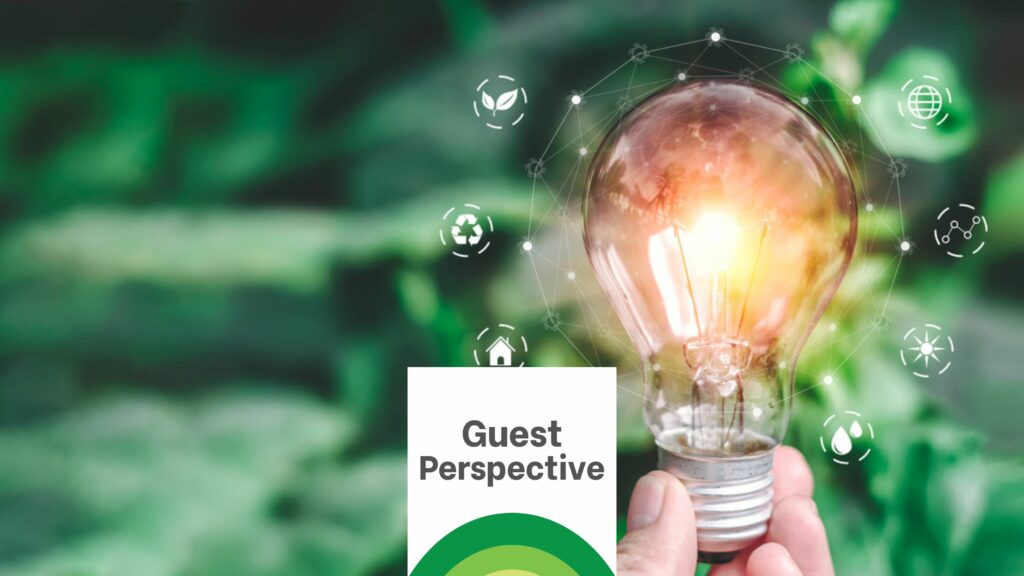
BRITANY AFFOLTER-CAINE, IS THE EXECUTIVE DIRECTOR OF MICHIGAN’S UNIVERSITY RESEARCH CORRIDOR Students and young adults see climate change and the preservation of our planet not as an impending challenge, but one with grave consequences that are impacting humanity today. Generation Z is more likely than older generations to act on their climate concerns through their purchasing power and in career choices. A majority of Gen Z are willing to spend 10% more money for sustainable brands according to a 2019 McKinsey report, and 42% of Gen Z respondents have already changed or plan to change their job or industry due to climate concerns according to a 2023 Deloitte survey. For these future leaders and doers, the greatest priority is to develop sustainable solutions to mitigate these impacts and the forces causing further environmental harm. Gen Z is not alone. Many university researchers, staff and administrators across Michigan’s University Research Corridor (URC) share their climate concerns and have made sustainability a priority area of research, education, innovation and service. An alliance of Michigan State University, the University of Michigan and Wayne State University that is dedicated to improving the quality of life for its region while advancing knowledge at a global level, the URC is committed to bringing all its resources to tackling climate change and mitigating its impacts today and in the future. Sustainability is an imperative we define as efforts to discover ways to meet the economic and health needs of people today while meeting the needs of future generations to thrive in ways that are effective, just and equitable. Sustainability includes decarbonization, clean energy innovation, reducing waste and pollution and managing limited resources, such as water. The sustainability work of URC researchers and students stretches across dozens of academic fields and within dedicated schools and colleges, such as U-M’s School for Environment and Sustainability, and includes partners in our communities, government and industry. Development of sustainable technologies, knowledge and practices is critical for addressing climate change and is good for our economy. For example, Michigan’s mobility sector is accelerating its transition to a more sustainable and eco-friendly industry. It is reshaping the way people think about transportation, pushing automakers to innovate, and encouraging governments and businesses to invest in a cleaner future. The URC universities play a key role in developing new technologies to support the mobility industry’s transition. Over the past five years, Michigan’s URC universities conducted more than $565 million in mobility-related R&D, which included sustainability-focused research, such as light weighting vehicles through advanced materials, energy storage to extend battery range for vehicles and alternative fuels that are more sustainable, such as hydrogen. The contributions our universities are making to support sustainability in the market can be seen in our strategic innovation partnerships with industry, like at MSU’s top-ranked School of Packaging, where researchers are working alongside industry leaders to reduce the amount of plastic waste in landfills and water systems by streamlining the different types of plastics that are used in manufacturing. MSU is also a leader in mass timber research, studying everything from structural performance and cost savings to fire resistance and sustainability. Made from a renewable resource, mass timber stores carbon and is less carbon-intensive to produce than other common building materials. U-M’s BioMatters team has developed their own sustainable solution for construction using upcycled sawdust. This fully biodegradable, reusable and recyclable material is formed into molds using 3D printing and can replace concrete formwork traditionally used across the construction industry. These molds are like giant LEGO pieces that can be used again and again. At a time when the consequences of climate change are increasingly evident and devastating, the need for sustainable solutions across all sectors has never been more urgent. This starts on our own campuses, where we all have implemented comprehensive sustainability initiatives that encompass various aspects of campus life. We’ve invested in energy-efficient infrastructure, adopted renewable energy sources, and reduced greenhouse gas emissions through innovative technologies and conservation efforts, showing that the URC is not only contributing to a greener Michigan but also setting an example for institutions nationwide. From lead in drinking water and intergenerational impacts of pollutants to mitigating development of fatbergs in our wastewater systems to storm water management, Wayne State has been studying the impacts of climate change and environmental threats to human health on residents and communities in Michigan’s largest city, Detroit. Old pollutants left behind by factories and other industries in the past are causing problems for people and the environment today. Supported by an $11.5-million National Institutes of Health grant, Wayne State University’s Center for Leadership in Environmental Awareness and Research is studying these old pollutants in cities, identifying how they move around and their impact on the health of mothers and babies. Our commitment extends to our work in sustainable action in communities across Michigan and the world. Michigan is renowned for its abundant freshwater resources, including the Great Lakes, which contain about 20% of the world’s surface freshwater supply. The presence of these vast water bodies makes our institutions leaders in research on water-related issues and solutions. The United Nations tapped Wayne State University and the University of Windsor to head its Regional Centre of Expertise on Education for Sustainable Development in the Detroit-Windsor region. The partnership will address community health, equitable city-building practices, public transportation, clean water, sustainable urban planning and housing policy, to better our two communities that share an international border. U-M recently received a $5 million grant to study how climate change is affecting water resources in different areas, especially when those areas share borders. This research will help us understand how rising temperatures and changing weather patterns are impacting our water supply, like rivers and lakes, and lead to better ways to manage and protect these vital sources of water. Sustainability is already becoming the heart of academic and industry research. Not only are environmental and economic pressures mounting, but our next generation of thinkers and leaders are dedicating their lives to addressing these
Bosch and Sustainability in Detroit
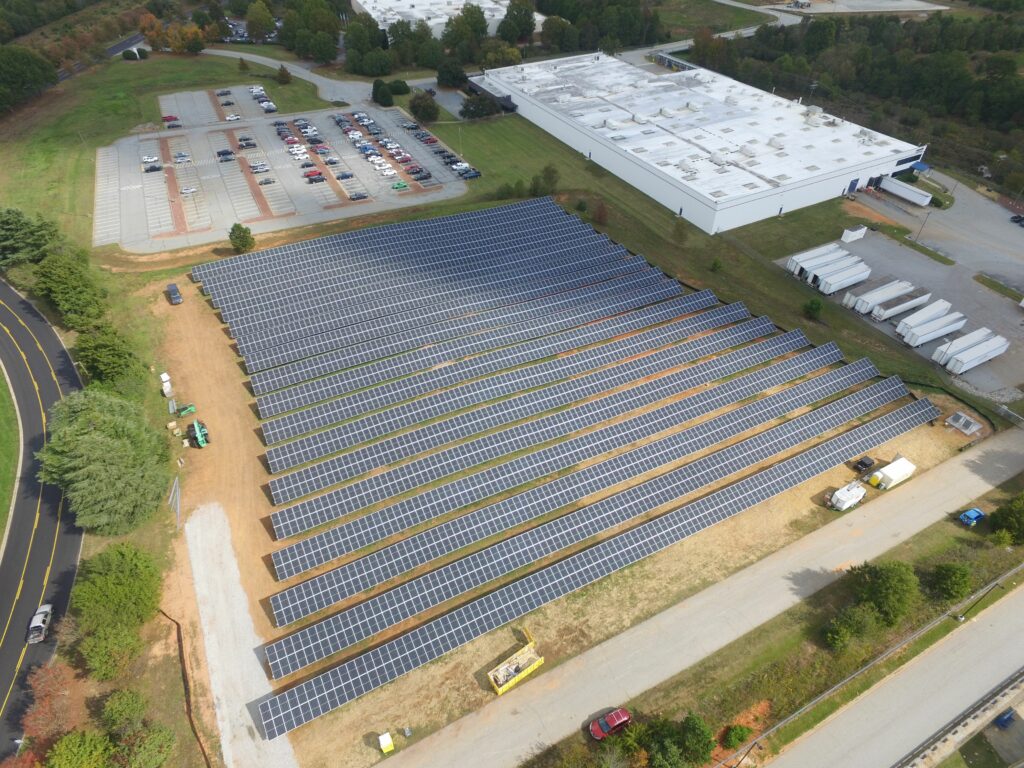
Bosch is a Germany-based global supplier of technology and services that employs 421,000 employees worldwide in over 60 companies. It has technical centers in Farmington Hills and Plymouth. We spoke to Tracy Rosol, carbon neutrality coordinator for the U.S. and Canada, about how the company approaches and manages sustainability. Q: How does Bosch approach carbon neutrality? A: In 2019, our leadership announced that Bosch would become 100% carbon neutral. We established committees in a multitude of countries and put key people in place to procure new green energy and carbon credits to offset emissions. We created a database where locations worldwide submit information like how much energy, water, and gas each is using. Q: What is your role in this? A: Germany is our hub and all initiatives roll out from there and cascade down. My main role at Bosch is operations support analyst – and I am also the carbon neutrality coordinator for the US and Canada. We have a carbon neutrality coordinator in every country. Q: What are your goals in this role? A: We had requirements to be 100% carbon neutral, and we reached that goal in 2020. It was not an option to fail. The entire company – over 400 locations worldwide – has reached this goal. Q: Tell us about some of the internal initiatives Bosch has implemented to protect the environment. A: Bosch works to invent things to make life better. We are working on different fuel systems, working on recycling programs, and composting programs. Within the facilities, there are many initiatives to ensure we are landfill-free. We work with local amenities for plastic pickup. Our cafeterias use compostable items and composting bins. What trash we do have is incinerated. We are working on technologies to reduce energy usage in our plants and also in homes. All of our lighting has now been changed to LED and we use motion detectors. We are working to install solar on sites. Bosch purchases carbon credits on behalf of all employee flights in an effort to offset flight emissions. It’s built into travel costs. This is all driven globally. Q: What is the sustainability approach when it comes to products? A: Let’s just use a pen as an example of a product. Bosch’s goal, as well as the OEM’s, is to make sure the entire process of developing this pen is sustainable. This involves what materials are being used, where the materials are procured from, what ink is being used, the packaging, the transport … all along the chain every piece needs to be sustainable. We are also pushing all other businesses we do business with to utilize sustainable practices. Q: What are the challenges? A: The biggest challenge is ensuring where our renewable energy credits come from and making sure all locations are being issued the credits for the recs. The challenge is tracking it. This involves handling a lot of data across all locations. Additionally, the market is challenged because so many companies are looking to procure renewable energy. This causes the price to fluctuate, and it’s a constantly changing market. We don’t want to over-purchase or under-purchase so it’s a challenge to manage this. Q: How are partners vetted when it comes to sustainability? A: We have a third-party vendor that is directly connected to the markets so they do this for us. We also have an external legal company. Bosch is not an expert in these areas and won’t pretend to be, so we go to the experts and use them to assist us in all of this. Q: What advice do you offer to businesses looking to contribute to sustainability overall? A: Begin with low-hanging fruit. Take a look at where you are wasting energy and start to make a change. Things like putting in motion detectors and switching to LED are good places to start. Reduce where you can. Utilize composting. Put recycling processes in place. From there, find a reputable company to walk you through it. Companies like Honda have partnered with Detroit Edison to put on webinars. Attend the webinars and begin to learn. Find ways to lean on experts and use their resources. Bosch did not do this overnight. We started in 2016 and worked at it over time. Be sure to subscribe to our newsletter for regular updates on sustainable business practices in and around Detroit.


